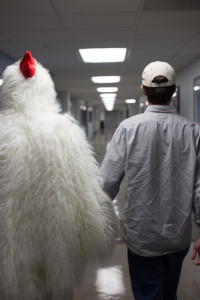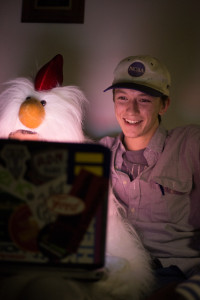

Things have changed a lot over the years. We’ve got faster computers, smarter phones and slightly more equality. These, of course, are changes people experience in day-to-day life.
Another, more subtle change society has experienced recently, is a change in meaning of the phrase “my fine, furry friend.” What used to be used to describe our pets can now be used to describe a subset of society that call themselves the Furry Fandom.
According to WikiFur, the Furry encyclopedia, the Furry Fandom is a group of people who appreciate “anthropomorphic animals in art, literature, cartoons, [and] pop culture…” Basically, this means they have an interest in animals with human attributes.
Very few people have had experience with Furries outside of television. Unfortunately, the media tends to portray Furries in an incredibly negative light. Natalie Tindall, Ph.D., a professor at Georgia State who has done research on the development of fandoms, said her first experience with Furries was on an episode of “CSI: Crime Scene Investigation.”
A man was killed in his fur suit. Tindall went on to say that Furry culture “tends to be very – at least from the media portrayals of it – it tends to be very sexualized.” This media portrayal has led many to believe that being a Furry is primarily a fetish, when in reality, it is a community
The beginnings of the furry fandom can be traced back to the post-World War II era, when cartoons about human-like animals shifted from an all-age focus to being primarily directed towards children.
According to WikiFur, these children then grew up with the desire to create similar characters for older age groups. In his autobiography, “Surprised by Joy,” author C.S. Lewis admits to developing his own fascination with anthropomorphic animals at a young age. Was C.S. Lewis a Furry? Who can say, but he did certainly like fawns.
The first open “Furry Party” at a notable convention was in 1986. Westercon, a science fiction convention held in Sacramento, was the first to showcase furry artwork and short stories at their 39th convention. The success of this party eventually led to the showcasing of furry fanfictions and fanart across California.
Since then, standalone Furry conventions have boomed in popularity, with more than 30 hosted across the country, the most popular being Anthrocon in Pennsylvania, which had more than 6,000 attendees last year.

Photo Illustration by Dayne Francis | The Signal
One reason Furry Fandom has exploded is the rise of Internet and Wi-Fi, which allowed people to build a community with others who shared their interests in a safer environment.
Tindall believes this sense of community can offer members of the Furry Fandom a sense of escape from their daily lives.
“They have something. They have a sense of whimsy and a sense of fun and a sense of belonging, and they just want to enjoy it. and it’s pleasurable and in this time why wouldn’t you want to have some escapism,” Tindall said.
While Tindall may be right theoretically, she cannot give a clear insight into what it’s like to live as a Furry, so The Signal sat down with Jason*, 31, whose Fursona is called “Wolf Genesis.”
*Names in article withheld to protect the identity of those in this story.
What’s it like to be a Furry? Is it like being part of other fandoms?
J: “It’s like anything else, I suppose. Like any fandom, you’ll have the aspects you absolutely love about it, and other aspects not so much.”
Do you have a fur suit?
J: “I don’t have a fursuit, though I admit I want one. They do cost a pretty penny, though. Full body suits that can range at a thousand dollars and more, to partial suits – that is, handpaws, footpaws, tails, or headpieces – which are naturally less costly.”
How involved are you with Furry life?
J: “I am an artist. I draw furries. I do have a tail that I wear from time to time, and collect various things involving. . .wolves. I haven’t gone out of my way to join profile pages such as Facebook for furries, unless you count my art page. Otherwise, I do play a game that is a heavily text based role playing game.”
What drew you to the lifestyle?
J: “I honestly think there are a number of factors that come into play here. One being…[the] childhood cartoon shows I grew up with. Sonic the Hedgehog, Tailspin, Road Rovers, SWAT Kats, and Biker Mice From Mars, to name a few. Seeing so many characters given human style characteristics, voices, acting became a part of me in a sense, and reminders of those happy times of childhood play a huge part in my enjoyment of the fandom. Another thing is the artwork. People can create constantly unique combinations and hybrids of things, detail it in ways we couldn’t imagine before, and bring things to life that is basically candy for the eyes.”
Are there any myths you want to dispel about being a Furry?
J: “Definitely. Being a Furry does not necessarily mean I’m in love with animals or have any sort of zoophilia. Being a Furry ranges from simply having a fascination with anthropomorphic beings, to… well, yes the extreme sense of sexual attraction. But I would like to impress that the main difference in being a furry versus a zoophiliac, involving the fantasies on the extreme end, is consent. Being a furry does not equal being into bestiality. The second myth is it’s all sexual and fursuits. It’s really not. That is one sect that gets a lot of attention, but not really the fandom as a whole. Some furries, like myself, love the fandom because it can personify traits we’d like to see in ourselves, or traits from connections we have with animals, as some feel with spirit animals or spirit guides.”
Do you think Furries will ever be fully accepted?
J: “The furry fandom will make it to being accepted when facts make it out first. When the myths and assumptions are widely no longer accepted, when people see that we’re rather a harmless bunch. A little odd maybe but what fandom isn’t?”
Even though we have a long way to go until Furries are accepted in society, that’s not going to stop people like Jason from living their lives true to themselves. The Furry Fandom is still growing and evolving every day.

Hmm, an article about furs written by someone named “CATrina”? sounds suspicious to me…
Hmm, an article about furs written by someone named “CATrina”? sounds suspicious to me…
[Sorry, wrong Email address before]